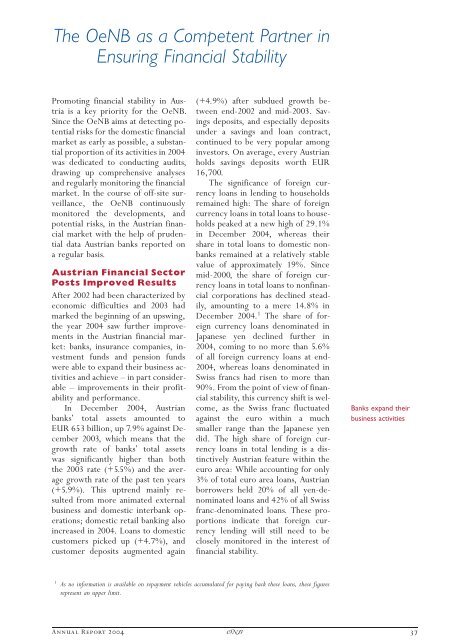Create successful ePaper yourself
Turn your PDF publications into a flip-book with our unique Google optimized e-Paper software.
The OeNB as a Competent Partner in<br />
Ensuring Financial Stability<br />
Promoting financial stability in Austria<br />
is a key priority for the OeNB.<br />
Since the OeNB aims at detecting potential<br />
risks for the domestic financial<br />
market as early as possible, a substantial<br />
proportion of its activities in <strong>2004</strong><br />
was dedicated to conducting audits,<br />
drawing up comprehensive analyses<br />
and regularly monitoring the financial<br />
market. In the course of off-site surveillance,<br />
the OeNB continuously<br />
monitored the developments, and<br />
potential risks, in the Austrian financial<br />
market with the help of prudential<br />
data Austrian banks reported on<br />
aregularbasis.<br />
Austrian Financial Sector<br />
Posts Improved Results<br />
After 2002 had been characterized by<br />
economic difficulties and 2003 had<br />
marked the beginning of an upswing,<br />
the year <strong>2004</strong> saw further improvements<br />
in the Austrian financial market:<br />
banks, insurance companies, investment<br />
funds and pension funds<br />
were able to expand their business activities<br />
and achieve — in part considerable<br />
— improvements in their profitability<br />
and performance.<br />
In December <strong>2004</strong>, Austrian<br />
banksÕ total assets amounted to<br />
EUR 653 billion, up 7.9% against December<br />
2003, which means that the<br />
growth rate of banksÕ total assets<br />
was significantly higher than both<br />
the2003rate(+5.5%)andtheaverage<br />
growth rate of the past ten years<br />
(+5.9%). This uptrend mainly resulted<br />
from more animated external<br />
business and domestic interbank operations;<br />
domestic retail banking also<br />
increased in <strong>2004</strong>. Loans to domestic<br />
customers picked up (+4.7%), and<br />
customer deposits augmented again<br />
(+4.9%) after subdued growth between<br />
end-2002 and mid-2003. Savings<br />
deposits, and especially deposits<br />
under a savings and loan contract,<br />
continued to be very popular among<br />
investors. On average, every Austrian<br />
holds savings deposits worth EUR<br />
16,700.<br />
The significance of foreign currency<br />
loans in lending to households<br />
remained high: The share of foreign<br />
currency loans in total loans to households<br />
peaked at a new high of 29.1%<br />
in December <strong>2004</strong>, whereas their<br />
share in total loans to domestic nonbanks<br />
remained at a relatively stable<br />
value of approximately 19%. Since<br />
mid-2000, the share of foreign currency<br />
loans in total loans to nonfinancial<br />
corporations has declined steadily,<br />
amounting to a mere 14.8% in<br />
December <strong>2004</strong>. 1 The share of foreign<br />
currency loans denominated in<br />
Japanese yen declined further in<br />
<strong>2004</strong>, coming to no more than 5.6%<br />
of all foreign currency loans at end-<br />
<strong>2004</strong>, whereas loans denominated in<br />
Swissfrancshadrisentomorethan<br />
90%. From the point of view of financial<br />
stability, this currency shift is welcome,<br />
as the Swiss franc fluctuated<br />
against the euro within a much<br />
smaller range than the Japanese yen<br />
did. The high share of foreign currency<br />
loans in total lending is a distinctively<br />
Austrian feature within the<br />
euro area: While accounting for only<br />
3% of total euro area loans, Austrian<br />
borrowers held 20% of all yen-denominated<br />
loans and 42% of all Swiss<br />
franc-denominated loans. These proportions<br />
indicate that foreign currency<br />
lending will still need to be<br />
closely monitored in the interest of<br />
financial stability.<br />
1 As no information is available on repayment vehicles accumulated for paying back these loans, these figures<br />
represent an upper limit.<br />
Banks expand their<br />
business activities<br />
<strong>Annual</strong> <strong>Report</strong> <strong>2004</strong> ×<br />
37
















